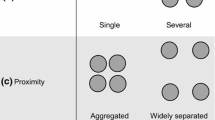Abstract
The ideas of classical island biogeography1 have been used2–6 to derive rules for the optimal design strategy for nature reserves. For example, Diamond3 states that, given limited (financial) resources, it is better to purchase a few large reserves rather than many small ones of equal total area; and that reserves should be as close to one another as possible. The validity of some of these rules has, however, been questioned7–10; for example it has recently been shown9,10 that several small reserves may contain more species than a single one of equivalent area. These rules have nevertheless been accepted uncritically by others, including the IUCN11. Here, I examine Diamond's rule3 that reserves should be as round as possible and conclude that in certain circumstances the optimal shape may be other than circular. There is no a priori reason for believing that these circumstances are unrealistic, and I know of no observational evidence to suggest whether they are found in nature or not. I also reason that the rule that reserves should be as close to each other as possible is inconsistent with the statement that they should be circular.
Similar content being viewed by others
References
MacArthur, R. H. & Wilson, E. O. Evolution 17, 373–387 (1963); The Theory of Island Biogeography (Princeton University Press, 1967).
Terborgh, J. Bioscience 24, 715–722 (1974); Tropical Ecological Systems, Trends in Terrestrial and Aquatic Research (eds Golley, F. B. & Medina, E.) 369–380 (Springer, New York, 1975).
Diamond, J. M. Biol. Conserv. 7, 129–146 (1975).
Diamond, J. M. & May, R. M. Theoretical Ecology, Principles and Applications (ed. May, R. M.) 163–186 (Blackwell, Oxford, 1976).
Wilson, E. O. & Willis, E. O. Ecology and Evolution of Communities (eds Cody, M. L. & Diamond, J. M.) 522–534 (Harvard University Press, 1975).
Hooper, M. D. The Scientific Management of Animal and Plant Communities for Conservation (eds Duffey, E. & Watt, A. S.) 555–561 (Blackwell, Oxford, 1971).
Simberloff, D. S. & Abele, L. G. Science 191, 285–286 (1976).
Abele, L. G. & Connor, E. F. Proc. First Conf. sci. Res. in The nat. Parks (ed. Linn, R. M.) Vol. I, 89–94 (1979).
Higgs, A. J. & Usher, M. B. Nature 285, 568–569 (1980).
Gilpin, M. E. & Diamond, M. D. Nature 285, 567–568 (1980).
Int. Union for Conservation of Nature and Natural Resources World Conservation Strategy (IUCN-UNEP-WWF, 1980).
Faeth, S. H. & Kane, T. C. Oecologia 32, 127–133 (1978).
Gilpin, M. E. & Diamond, J. M. Proc. nat. Acad. Sci. U.S.A. 73, 4130–4134 (1976).
Preston, F. W. Ecology 41, 611–627 (1960); 43, 185–215, 410–432 (1962).
Connor, E. F. & McCoy, E. D. Am. Nat. 113, 791–833 (1979).
Diamond, J. M. Proc. natn. Acad. Sci. U.S.A. 68, 2742–2745 (1971); Proc. natn. Acad. Sci. U.S.A. 69, 3199–3203 (1972).
Pickett, S. T. A. & Thompson, J. N. Biol. Conserv. 13, 27–38 (1978).
Diamond, J. M. Ecology and Evolution of Communities (eds Cody, M. L. & Diamond, J. M.) 342–445 (Harvard University Press, 1975).
Peterken, G. F. Biol. Conserv. 6, 239–245 (1974).
Author information
Authors and Affiliations
Rights and permissions
About this article
Cite this article
Game, M. Best shape for nature reserves. Nature 287, 630–632 (1980). https://doi.org/10.1038/287630a0
Received:
Accepted:
Issue Date:
DOI: https://doi.org/10.1038/287630a0
- Springer Nature Limited
This article is cited by
-
Disentangling spatial and island shape effects on bryophyte distribution in the Zhoushan Archipelago, China
Folia Geobotanica (2022)
-
Using tree population size structures to assess the impacts of cattle grazing and eucalypts plantations in subtropical South America
Biodiversity and Conservation (2010)
-
The influences of landscape structure on butterfly distribution and movement: a review
Journal of Insect Conservation (2009)
-
The challenge of assessing whether the OSPAR network of marine protected areas is ecologically coherent
Hydrobiologia (2008)
-
Spatial attributes and reserve design models: A review
Environmental Modeling & Assessment (2005)





